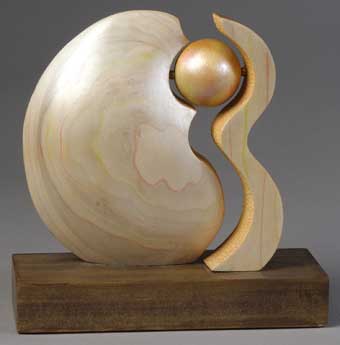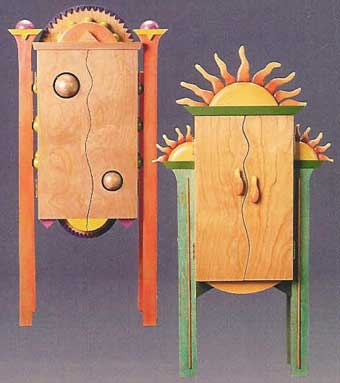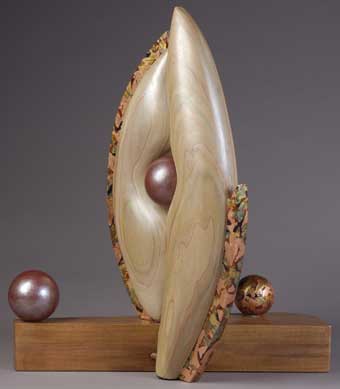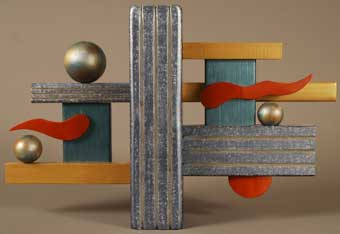
Rue Ann Flanders says she knows it’s strange, but, “I really enjoy sanding wood.”
That’s one reason she feels like she found her niche in wood sculpture after she took a class on the subject at the Marc Adams School of Woodworking. “I find grinding and sanding wood to be very therapeutic. It’s a little loud and a lot of dust, but you wear a dust mask and go on.”
Rue Ann’s wood sculpture recently earned her inclusion in the book Wood Art Today 2 from Schiffer Publishing (ISBN 978-0764334634), a coffee table book focusing on contemporary wood artists.
One example of her work in this line is her Blue Sculpture, which grew from a 2×4 challenge: “We had to make something using one construction grade 2 x 4 stud and one other element. I used the balls as my second element,” Rue Ann said. She likes that particular sculpture in part because of its shape, the “angularity, with wings on the sides.”
Shape is an area where she finds inspiration for her work, and fun. Rue Ann says she is constantly looking at shapes in glasswork, or jewelry, and she originally took the sculpture class in order to learn how to use dimensional aspects to the whimsical furniture she was building. She had already learned intarsia and knew that “I like curves better than I do straight lines and angular lines.”
For example, her Steer Cabinet tabletop furniture incorporates curved doors, with arches, and balls embedded into both the doors and the legs of the piece. “My doors are always curved,” Rue Ann said, and the piece itself is “very much fun, but also functional. It has piano-shaped drawers, that you can pull out and put jewelry or whatever in.”
Furniture, in a way, reflects Rue Ann’s original experiences with woodworking. When she was around nine or 10 years old, “my dad brought home a playhouse, but there was no furniture for it, so I would go down in the basement and grab tools and make furniture to go with it.” Since her dad was a television engineer who owned a drill and hand tools – no other power tools – for around-the-house use, that’s what the young Rue Ann used to construct her playhouse furniture from construction wood scraps. “I made a big coffee table, which was the only piece that didn’t fall apart,” she said. “I tried to make an end table, and make a living room setting in there, but everything else didn’t make it from the basement to the playhouse.
After that experience, it was a couple of decades later when her then-fiance decided Rue Ann should get into woodworking and bought her an inexpensive scroll saw. It sat in the basement for three years before she picked it up to make centerpieces for a friend’s wedding – and came to the conclusion that it was a horrible saw. She bought a better scroll, a drill and a sander, and fiddled around making “crafty things that I thought were silly, but I did them anyway” before she began making her furniture – in part because, “I would look at furniture and think, ‘I can make that.'”
These days, one of Rue Ann’s most used tools is an air-filled round pneumatic drum sander, the kind used in making boat parts and boomerangs. “I use that all the time,” Rue Ann said, but, even though she has built such things as a 7-foot tall armoire, she’s never used a table saw. “They scare me half to death,” she said. “I see too many people in the [Rockler Woodworking and Hardware Indianapolis, where she is assistant manager] store walking in without a finger.”
She does own a table saw, but has yet to resolve its wiring issues and turn it on. She does note that, “It makes a good table. I set things on it all the time.”
The wood that Rue Ann is not cutting on the table saw might be maple, for bases and cabinets, but she is more likely to work with poplar. As a softer wood, “it’s easier to shape and sculpt,” she said and, “because I do all kinds of finishes – painting, metal leafing – poplar works well. I can make poplar look like any other wood I want.”
Rue Ann does not use exotic woods because she prefers to finish with color. “I love color,” she says, which is reflected in, for example, her Steer Cabinet. “Kids are really attracted to it,” Rue Ann said, “because it has so many colors: fuschia, lime green, orange…”
While she does use natural wood as well, Rue Ann feels that she needs to marry the colored portions of her pieces with the natural wood. “The way I do that is by coloring the grain,” she said.
Speaking of “finish” in its sense of completion, Rue Ann said that she had a hard time picking a favorite among her works. “If it gets finished, I like it,” she said. “It’s not ego; I just like what I do.”








